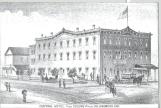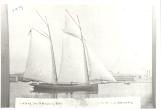14
Hundreds of working men came to the land of opportunity and found work. It was common for a young man to live at one of the hotels, if they were lucky enough to find lodging there. F. T. Hodgson wrote of the place that, even with all of the hotels in town, "thousands of people-at times- were forced to sleep on the wharf and docks. Every train-and specials-came in full to the doors-Scandinavians of all sorts, German and others, lined the wharfs, the hotel entrances, the sidewalks and every available dry spot was utilized for sleeping quarters…"Photo credit: Collingwood Museum Collection Accession Number X970.923.1
16
One of Collingwood's largest hotels was the Grand Central Hotel, owned by Thomas Collins. It was featured in the 1881 Belden Atlas for Simcoe County.Photo credit: Collingwood Museum Collection Accession Number 988.4.1
18
A harbour full of Collingwood Skiffs was a common sight in Collingwood between 1850 and 1900. An estimated 250 fishermen in the community brought in a catch worth $125,000, according to the Board of Trade report for 1893. The author of the report figured that $100,000 was invested in the industry, including boats, nets, equipment and facilities.Photo Credit: Collingwood Museum Collection Accession Number X971.894.1
20
Mocking Bird was a fast sailing boat built by William Watts for his boatbuilder friend Patrick Doherty. The Mocking Bird was once the fastest sailing vessel in the Collingwood area, and won the Collingwood Regatta Cup in the 1870's.Photo credit: Collingwood Museum Collection
22
William Watts, joined by his sons Matthew and Frederick in the 1890's, were responsible for creating a solid business reputation for excellent design, sailing capability, and solid construction. Designed for Georgian Bay's unpredictable and fierce weather, their sailing vessels were known worldwide as the "Collingwood Skiff." Only one original Collingwood Skiff still exists.Photo credit: Collingwood Museum Collection Accession Number X969.288.1
24
The first members of the North West Mounted Police were recruited mainly in the Provinces of Ontario and Quebec with some representation from the Atlantic Provinces. Most of these men had some previous military experience mainly in the Canadian Militia. They were transported by rail to the Port of Collingwood where they were issued with essential equipment in preparation for their journey to lower Fort Garry in Manitoba via the Dawson Route, and all Canadian way over land and water to the area of Red River. The first stage of the trip was by steamship from Collingwood to Prince Arthur's Landing (Thunder Bay). The men embarked in stages over several days on three ships, The Cumberland, The Chicora and The Frances Smith.The cairn was raised at Harbourlands Park in 2000.
Photo courtesy of: Collingwood Musuem
26
One of the first grain terminals on the Great Lakes, the first elevators at Collingwood stored grain from the area's pioneer farmers, as well as wheat from Western Canada. Local industry that depended upon the water show up in the foreground of this engraved print of the second elevators. Local boys became sailors on the grain-filled schooners, merchants sold their wares to the passengers on the steamers, and dozens of men were employed at local sawmills.Photo credit: Collingwood Museum Collection Accession Number 990.17.1






